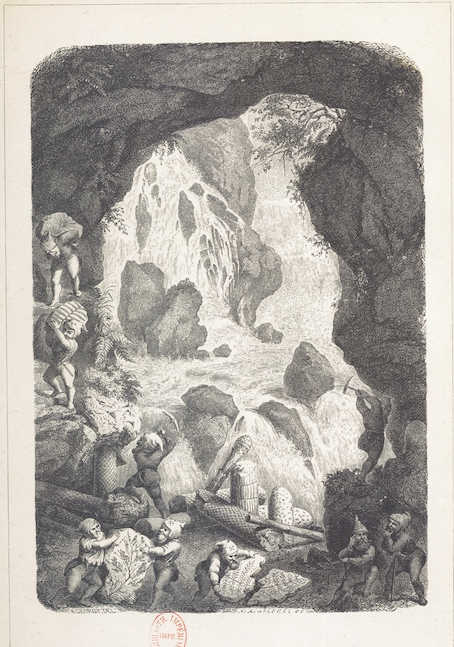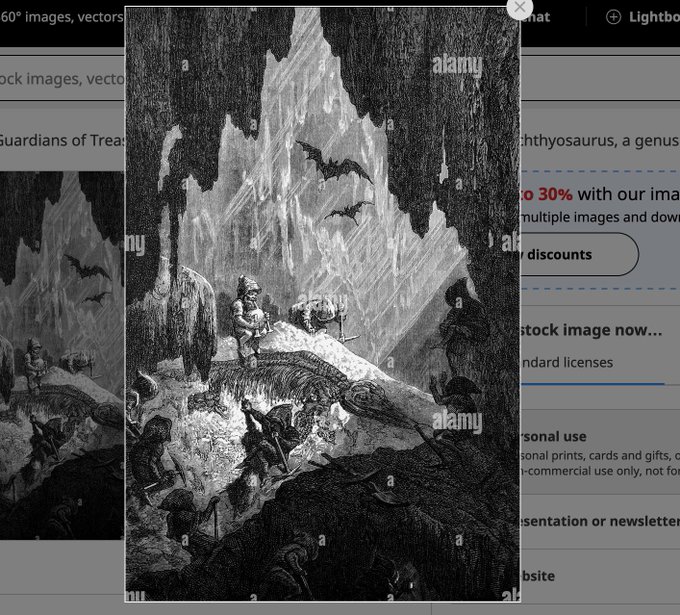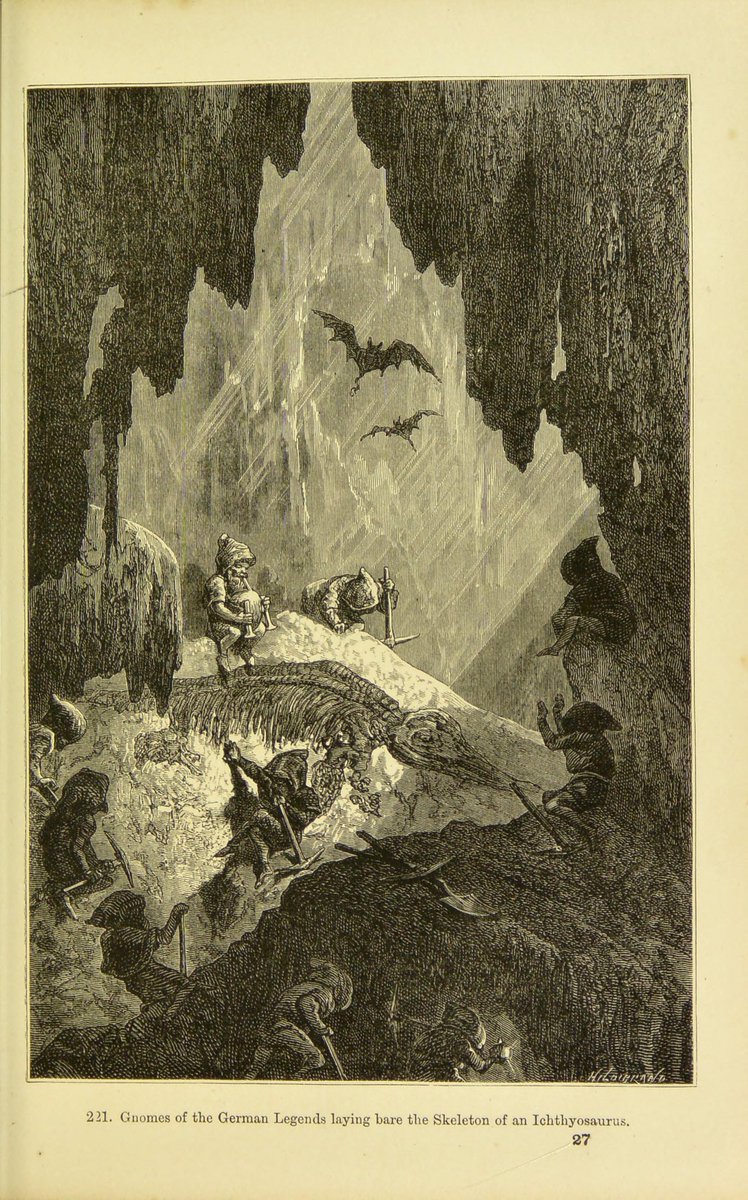
January 14, 2022, by Brigitte Nerlich
Gnomes, ichthyosaurs and 19th-century science communication
Last weekend I had an interaction on Twitter that got me away from doomscrolling and transported me back to my safe place, namely the 19th century.
In my past life, when I was very young, I wrote a Staatsexamensarbeit, a sort of MA for people on the teacher training track (I never went to the end of that track), on the illustrations in the work of Jules Verne. I got funding to work in the Bibliothèque Nationale in Paris and in the libraries of Amiens and Nantes, which I enjoyed a lot. I later wanted to turn this little piece of rather amateurish work into a thesis but that didn’t happen. However, ever since then I have been fascinated by 19th-century science illustrations, especially those used in the ‘vulgarisation’ or popularisation of science.
So, when I saw a tweet by Richard Fallon, author of Creatures of another Age asking for help with finding out where a puzzling illustration, picturing gnomes and an ichthyosaur in a cave, was first published, I was intrigued. (I seem to be making a habit of this, as the same thing happened with an engraving of an iguanodon).
This engraving reminded me of illustrations in Jules Verne’s work, such as this one by Édouard Riou from Voyage au Centre de la Terre (1864) depicting a subterranean sea. Later on the protagonists “catch fish of extinct species, and, after several days of sailing, they come across an ichthyosaur and a plesiosaur fighting”.
But the gnomes puzzled me; Verne’s stories never had gnomes as far as I know and I also couldn’t remember them from other illustrated science publications.
Oh, and what about the ichthyosaur? What a strange coincidence that an ichthyosaur (or ‘sea dragon dinosaur dolphin‘) was just in the news, one discovered not so far away from Nottingham in Rutland Water! And what a coincidence that this happened almost exactly 200 years after Mary Anning’s brother Joseph discovered the first fossilised ‘sea monster’ in 1811! But that’s another story!
Back to the strange illustration flagged up Fallon – see here in its original environment. In the end, one clever Twitter detective, Denver Fowler, found its origins. It was used in Félix Archimède Pouchet’s popular science book L’univers; les infiniment grands et les infiniment petits (1865) – but only in the second edition of its English translation of 1874: The Universe; or, The infinitely great and the infinitely little. Interesting, I thought. So, I checked out the first edition of the French original from 1865 on the Bibliothèque Nationale website Gallica and the image really wasn’t there, but I found references to ‘gnomes’ and an image of an ichthyosaur skeleton which changed quite a bit in the second edition of 1868 and stayed the same after that.
Wow, I thought, in all my, albeit very sporadic, meanderings around the 19th century I had not heard about Pouchet. Who was Pouchet and what about the gnomes and the ichthyosaur?
Félix-Archmède Pouchet
Félix-Archimède Pouchet, (born Aug. 26, 1800, Rouen, Fr.—died Dec. 6, 1872, Rouen) was the son of a meteorologist who read Buffon in his youth (Buffon wrote the famous Histoire naturelle, générale et particulière, 1749–1788, in 36 volumes). He became a famous French naturalist and a leading advocate of the idea of the spontaneous generation of life from nonliving matter (which he called ‘hétérogénie’ and he wrote a book of the same title). This got him into trouble with Louis Pasteur and a famous and lengthy controversy ensued (1859-1864), with Pasteur ultimately the winner. Pouchet earned his living as the director of the Rouen Museum of Natural History and the Rouen Jardin des Plantes and later as professor at the School of Medicine at Rouen. It’s also worth mentioning that he was married to an Englishwoman, Anne Christie, and was friends with the biologist and comparative anatomist Richard Owen.
All the entries on Pouchet in Britannica, in Wikipedia etc. (from which I gleaned some of the above) mention his discredited theory of spontaneous generation, but nobody really points to other aspects of his life and work, it seems. I found one French thesis on Pouchet but have not been able to get access to it, despite my best efforts 🙁
I should mention that Bruno Latour has, of course, mentioned Pouchet in his book on the Pasteurisation of France and in his essay Pandora’s Hope and has also written at length about Pouchet and Pasteur – I still have some reading to do there.
By ferreting around in some French articles (see further readings), I uncovered three aspects of Pouchet’s life that should be mentioned alongside the Pasteur controversy, I believe:
- Pouchet’s efforts to popularise science, especially in his book on The Universe – I’ll get to that later.
- Pouchet’s work at the interface between science and literature, especially his relationship with Gustave Flaubert (author of Madame Bovary, 1857) whose teacher he was at Rouen and with whom he corresponded; Flaubert’s father, Achille Cléophas Flaubert, in turn has been Pouchet’s teacher, and Gustave was friends with Pouchet’s son George.
- Pouchet’s work at the interface between science and culture. He was not only interested in natural history, natural theology, biology, zoology, botany and medicine and much more, but also, for example, in the cultural history of zoology. He gleaned his cultural knowledge of natural philosophy and mythology by travelling far and wide and making copious notes and drawings. This comes through in his Universe, but perhaps even more so in his unpublished manuscript Histoire pittoresque et archéologique des oiseaux, but I’d have to travel to Rouen to see that 🙁
Somebody will have to write about all this – including about how his son, naturalist and anatomist Georges Pouchet (1833-1894), who became perhaps more famous than his father and might have influenced Jules Verne, persuaded him that Darwinism and the theory of evolution might have merits. It would also be interesting to find out how Pouchet was inspired by people like Antonie Leuwenhoek, Robert Hooke, Charles Lyell, Alexander von Humboldt, Jules Michelet, William Herschel and many more. And how, on the other hand, Pouchet was viewed by other popular science writers like Camille Flammarion or Louis Figuier.
Life, the universe and everything
Pouchet wrote many books about natural history but L’univers; les infiniment grands et les infiniment petits was, I think, his way of continuing the tradition of Buffon whose books he had read in his youth, just as I still read Brehm’s Tierleben in my youth, which was first published in the 1860s (but that didn’t turn me into a Pouchet!).
Pouchet’s book was one of many popular science books published at the time, alongside popular science fictional accounts of natural history, geography, travel and adventure by Jules Verne for example. Both Pouchet and Verne’s books were given to children as school prizes or ‘livres d’étrennes’ – New Year’s or, now, Christmas gifts. These books were highly decorated, gold embossed and just wonderful (see featured image of the 1872 French edition). Flaubert had a copy of the first edition on his shelves.
The Universe was a book about microscopic life and macroscopic life, covering the animal and vegetable kingdoms, geology and the sidereal universe. Microscopy became a popular pastime in the second half of the 19th century; so a book on the wonders of the microscopic creatures would have been popular. The same can of course also be said of corrals and fossils, birds and butterflies, planets, stars and nebula – which had just been discovered.
All such phenomena were pictured in Pouchet’s book by famous illustrators, some of which had also worked for Jules Verne, such as Albin Mesnel (1850-1950!) who did the wonderful colour plate of the humming bird that adorns the Universe from the 1872 edition onwards (I think). As Pouchet said in the preface to his book (I use here the 1874 English translation):
“The Publisher, who has shrunk from no outlay, has for this purpose placed at my disposal arts of the highest merit, in whose co-operation I have been very fortunate. I have especially to thank M. Faguet, assistant naturalist at the Sorbonne, who, being at once an accomplished botanist and an excellent draftsman, has given quite a special character to the drawings of the plants; also M. Mesnel, who has drawn the zoological illustrations with such taste; and lastly M. Émile Bayard [he gets a first name!] to whose pencil we owe some charming landscapes.” (p. vii) (People might want to know that Bayard did the drawing of Cosette for Victor Hugo’s Les Misérables (1862) which became the logo for the well-known musical adaptation)
Although individual illustrations are not attributed to illustrators in the various editions of The Universe, we might assume that Bayard executed our mystery illustration. He also illustrated, for example, Jules Verne’s De la terre à la lune (From the earth to the moon) of 1867.
The gnomes and the ichthyosaur
As I said, the mysterious illustration of gnomes unearthing an ichthyosaur (or “veritable fish lizard”) in a cavern surrounded by bats only appeared in the English translation of 1874 (p. 609) (illustration 277, subtitle: “Gnomes of the German Legends laying bare the Skeleton of an Ichthyosaurus”).
However, when glancing through the first, 1865, French edition, I found the word ‘gnomes’ (p. 432 footnote 112; second edition, p. 549) – a rather English word – in the context of Pouchet talking about a German botanist only referred to as Schleiden throughout the book. This was Matthias Jakob Schleiden (1804-1881). He was a German botanist and co-founder of cell theory, along with Theodor Schwann and Rudolf Virchow. He also wrote a popular book on plants that Pouchet admired: La Plante et Sa Vie: Leçons Populaires de Botanique a l’Usage Des Gens Du Monde (1859).
Going now to the English edition of 1874 (pp. 719-720), we also find, of course, references to gnomes and elves and even Kobolds – what is that all about? In a footnote on p. 720 Pouchet says about Schleiden:
 “In his work on The Plant (La Plante) there is a beautiful engraving, representing little gnomes laboriously occupied in laying bare all the riches of earth. Some hew the rock in order to withdraw large trunks of fossilized trees; others collect or solder together the torn fragments. Each gnome or Kobold appears under the form of a little laborious and decrepit miner. The back-ground of the picture is occupied by a cascade which bound and foams among the rocks. – Schleiden, La Plante, pl. 13.” As you can see, there gnomes galore as well as fossilised plants and wood but no ichthyosaur.
“In his work on The Plant (La Plante) there is a beautiful engraving, representing little gnomes laboriously occupied in laying bare all the riches of earth. Some hew the rock in order to withdraw large trunks of fossilized trees; others collect or solder together the torn fragments. Each gnome or Kobold appears under the form of a little laborious and decrepit miner. The back-ground of the picture is occupied by a cascade which bound and foams among the rocks. – Schleiden, La Plante, pl. 13.” As you can see, there gnomes galore as well as fossilised plants and wood but no ichthyosaur.
This passage must have inspired one of the illustrators, probably Bayard, to create the image in the English edition, especially as all editions contain an illustration of an ichthyosaur skeleton (1865, p. 290; second 1867, p. 549; 1874 English translation, p. 611 – possibly by Auguste Faguet)
Pouchet and the popularisation of science
There is a lot one could write about Pouchet and the popularisation of science in the 19th century. One blog post is decidedly not enough. I’ll close with a quote from Pouchet’s preface to The Universe, which sums up his philosophy of public engagement with science.
“Whoever aspires to the title of a philosopher [savant in the French edition; scientist in modern parlance] has, in the present day, a double mission to perform – to discover and to popularize [vulgariser]; he should labour on the one hand for the advancement, on the other for the diffusion, of science. The zoologists and botanists who shed the greatest lustre on our modern epoch, have shown, by the publication of their contributions on natural history, that they appreciate this sacred mission. I have here only imitated them in a somewhat more extended manner, and hope I shall be pardoned for following such an example.” (1874, p. vii)
PS, 1 February 2022: The picture discussed here now adorns a call for papers. Looking into this call I found a quote from Charles Dickens, which needs mentioning in the context of this blog post!! “Science has gone down into the mines and coal-pits, and before the safety-lamp the Gnomes and Genii of these dark regions have disappeared … From within them she has brought the bones, and pieced together the skeletons, of monsters that would have crushed the noted dragons of the fables at a blow.” Charles Dickens, review of The Poetry of Science by Robert Hunt, Examiner (9 December 1848)
Further readings
Cantor-Coquidé, M. (1992), Félix-Archimède Pouchet, savant et vulgarisateur. Thèse de doctorat (Orsay: Université Paris-Sud). https://www.theses.fr/1992PA112482a [no access]
Coquidé, M. (2015). Félix-Archimède Pouchet, professeur de sciences naturelles de Flaubert. Flaubert. Revue critique et Génétique, (13).
Crellin, J.K. (1981), Pouchet, in Gillispie, C.C. (ed.), Dictionary of Scientific Biography (New York: Charles Scribner’s sons), 11: 109–110. [I didn’t get access]
Fox, R. (2012). The savant and the state: science and cultural politics in Nineteenth-Century France. JHU Press.
Husti, C. (2017). La pluralité des races humaines de G. Pouchet: l’imaginaire des discours scientifiques. Studia Romanica Posnaniensia, 44(4), 81-94.
Klinkert, T., & Séginger, G., eds. (2020). Littérature française et savoirs biologiques au XIXe siècle (p. 280). Berlin/Boston: De Gruyter.
Percheron, B. (2012). Georges Pouchet, les fonds marins et l’océanographie. Actes des Congrès Nationaux des Sociétés Historiques et Scientifiques, 135(11), 71-81.
Percheron, B. (2017). Esthétique de l’imaginaire et enjeux spiritualistes: La Terre avant le déluge de Figuier et L’Univers de Pouchet. Studia Romanica Posnaniensia, 44(4), 117-130.
Percheron, B. (2020). Écrire l’histoire naturelle au xixe siècle: le style de Félix-Archimède Pouchet. Arts et Savoirs, (14).
Image: The 1872 edition of L’Univers.
No comments yet, fill out a comment to be the first




Leave a Reply